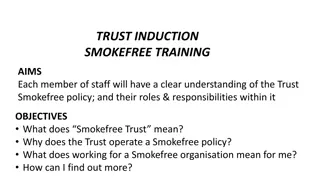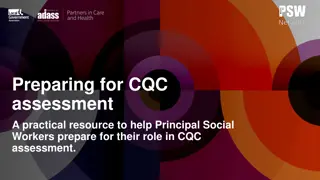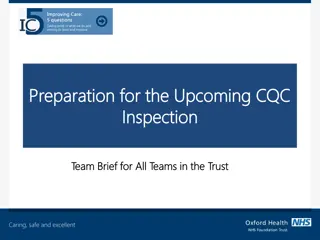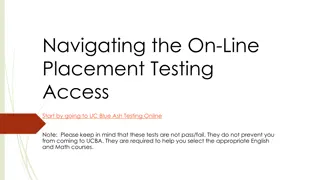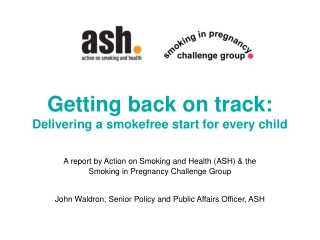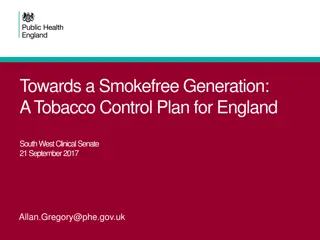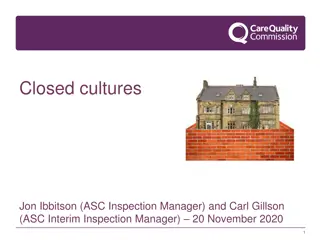Insights from ASH Lived Experience Group on CQC Smokefree Guidance
The ASH Lived Experience Group, composed of individuals with firsthand experience of mental health issues and smoking, reflect on the challenges related to implementing smokefree policies in mental health settings. They emphasize the importance of staff support, long-term health focus, and cultural considerations in successfully transitioning to smokefree environments. Their feedback sheds light on the need for a holistic approach that considers patient well-being and empowerment.
Download Presentation

Please find below an Image/Link to download the presentation.
The content on the website is provided AS IS for your information and personal use only. It may not be sold, licensed, or shared on other websites without obtaining consent from the author. Download presentation by click this link. If you encounter any issues during the download, it is possible that the publisher has removed the file from their server.
E N D
Presentation Transcript
Feedback on CQC Smokefree mental health settings guidance from the ASH Lived Experience Group
About the group The ASH Lived Experience Group is a small group of people who are experts by experience of mental ill health and smoking. All members of the group have spent time in inpatient mental health settings and all have a history of tobacco smoking. All our members also have patient representative or similar experience. Some group members are now vape/e-cigarette users.
What we asked We asked the group to reflect on any issues they have experienced that would affect the implementation of this guidance. This is an opportunity to hear a patient perspective on the guidance. The feedback demonstrates both concerns around implementation and why this guidance is important.
Staff need to be on board I experienced staff goading and teasing patients as they went on smoke breaks. Them coming back smelling of smoke is really difficult for us. Seeing others being treated differently by staff can be frustrating, and especially toxic for people who do not trust the system . This can exacerbate existing inequalities in wards. You would know which staff members would sneak you a cigarette and which wouldn t, this created frustration on the days that staff who would not bend the rules were in and create unhelpful inconsistency. Overall, it was clear patients have not experienced consistent buy- in and commitment to smokefree environments making it harder for patients to go smoke free.
Focus on long term health I feel like there is an assumption that patients will just go back to smoking once discharged staff should not just focus on keeping patients smokefree whilst on wards, but fully commit to helping them end their smoking for good. Those in inpatient mental health settings are concerned with their physical health as well as their mental wellbeing. Improving physical health can also be an important way to build hope and take back a sense of control over our health. Frame the smokefree policy in terms of an effort to improve health, rather than just as a restriction on freedoms in the ward.
Replace the culture Smoking breaks traditionally gave patients access to the garden or other outdoor spaces and provided a space for bonding both with fellow patients and staff. Smoking breaks were often where relationships were forged. Wards should work to make sure that going smokefree doesn t remove the social and environmental opportunities smoke breaks offered. You can t separate out a smokefree policy from the ward culture as a whole, it has to be viewed in context. If you create a therapeutic environment and consider how the ward culture can contribute to helping people go smokefree, you will likely have a lot more success implementing this. Replace the culture around smoking as well as the tobacco products.
Respect patient autonomy When you are admitted to an inpatient setting you are already losing a lot of freedoms, having further rules imposed on you that others out in the world don t have to abide by can feel really unfair. Having your tobacco taken is like this. If staff could offer patients vaping materials as a trade at the point when tobacco is removed, framing it as an exchange this would feel less repressive. Feeling like you have autonomy over your care is so important, this is why communication of these policies is key to ensure patients understand policies and have been given a chance to discuss how they feel about it. Knowing who on the ward you ask for further support would also be important to communicate on admission Policies should treat patients with respect and dignity
Incentivise alternatives Its important to have a range of vapes available, including different nicotine strengths and flavors so that patients have choice. Vapes should be treated in line with how other medication for physical health issues is treated, there should be consistent availability. This includes a plan for people accessing vapes once back in the community. Free vapes are a great incentive, but they could be supported with other incentive schemes such a regular Co2 monitoring, which could track progress and be rewarded in other ways on the ward to bring positive consequences Treat smokefree policies like you need to persuade people to opt in
Thank you If you would like further detail on any of the topics discussed today or would like more information on our lived experience group please get in touch- elliot.smith@ash.org.uk



